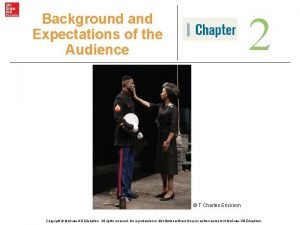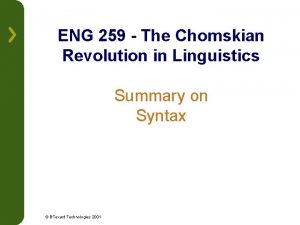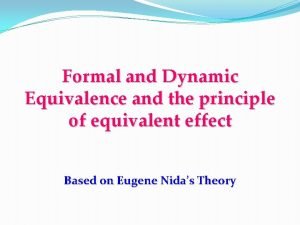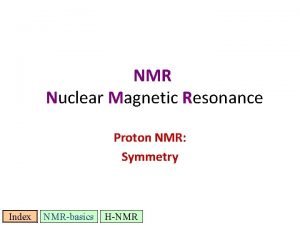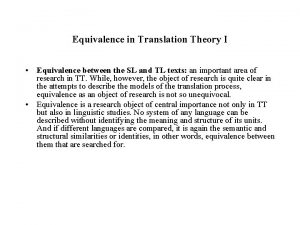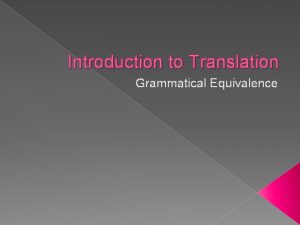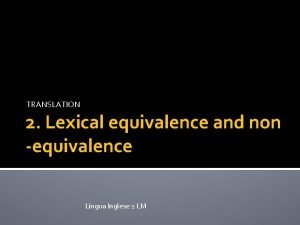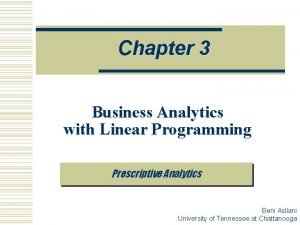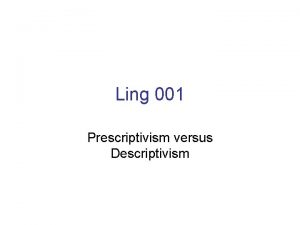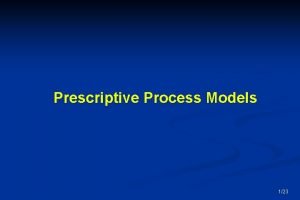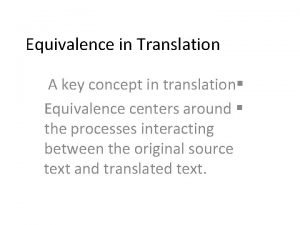Translation as a product Equivalence Descriptive Prescriptive Descriptive

















- Slides: 17

Translation as a product Equivalence: Descriptive Prescriptive


Descriptive Equivalence • • • Forbidden is the entrance = Forbidden is the smoking = Forbidden is the photography = In the safety of God = With the well-being =

Prescriptive Equivalence • The relationship between an SL expression and the canonic/basic/standard/TL required rendering. – No entry! – No smoking! – No photography! – Farewell! Adieu! – Goodbye!

“Dynamic Equivalence” • This variant is based on the ‘principle of equivalent effect’ = ‘the relationship between TA and message = should be substantially the same as that between SA and the message’. • However, reasons of grammar, idiom, context, genre, etc. may forbid literal translation of expressions.

Communicative Translation an example of Dynamic Equivalence • Excessive freedom in translation – To write more or less anything as long as it sounds good and thinly reflects something of the SLMC. • What could be the relationship between STM and SCR/A? ! • Is there a single effect? !Even in one reading by one person? !

Equivalence is not Sameness • In mathematics / sign-theory / an equivalent relationship is objective / incontrovertible / reversible. • In translation reversibility / unanimity / full agreement / is unthinkable! • It can be only in very simple texts and only denotatively!

Translation Depends on Context • Same is a hindrance in translation • Cultures differ!!!!!!! • We suggest an ‘Equivalent Target Culture Situation’ = in the everyday counterpart sense • Something different, but resembling in relative aspects

Translation Loss • • • To maximize sameness or To minimize difference Look not for what we might put into TT, but Look for what we might save from the ST. Because SL and TL are fundamentally different, the transfer from ST to TT involves loss.

Loss in Translation Deficiency versus compensation: • ( )ﺍﻟﻌﺠﺰ ﻣﻘﺎﺑﻞ ﺍﻟﺘﻌﻮﻳﺾ a deficiency occurs when a particular semantic or grammatical concept does not exist in either the SL or the TL. A compensation, on the other hand, is an attempt to make for that deficiency through some other means; i. e. the lack of the dual pronoun form of address in English: ﺃﻨﺘﻤﺎ can be compensated with the use of both to indicate duality, i. e. you both. •

Loss versus gain: • ( )ﺍﻟﻔﻘﺪ ﻣﻘﺎﺑﻞ ﺍﻟﺰﻳﺎﺩﺓ a loss in translation results from a semantic or structural deficiency in the TL which cannot be compensated for, while gain adds something which did not exist in the SL whenever the TL is semantically richer. For instance, ﺧﺎﻟﺔ translates into maternal aunt; thus, an extra semantic element is added to make for the deficiency in English. •

Saving versus padding: • ( )ﺍﻟﺒﻼﻍ ﻣﻘﺎﺑﻞ ﺍﻟﺤﺸﻮ saving is when the SL message can be translated in fewer words, and padding when it has to be expressed in more words. An example of saving in English: pensioner ; ﻣﺤﺎﻝ ﺇﻟﻰ ﺍﻟﺘﻘﺎﻋﺪ an example of padding: ﻓﻼﻥ ﻻ ﻳﺮﺍﻓﻖ , he is not the right companion because he has no manners. •

Language levels: • ( )ﻣﺴﺘﻮﻳﺎﺕ ﺍﻟﻠﻐﺔ they determine the type of languages to be used in translation: poetic versus prosaic, literary versus colloquial, refined versus vulgar, ancient versus modern, esthetical (artistic) versus functional, philosophical versus technical etc. The translator has to adapt the tone of the SL and target the audience targeted by the SL. One has to translate different language registers differently in the TL. •

Literal versus figurative sense: • ( )ﺍﻟﻤﻌﻨﻰ ﺍﻟﺤﺮﻓﻲ ﻣﻘﺎﺑﻞ ﺍﻟﻤﺠﺎﺯﻱ many words have both a concrete meaning and an abstract one, i. e. English: honey, ﻋﺴﻞ (literal sense); ﻣﺤﺒﻮﺏ (figurative sense).

Equivalence: • ( )ﺍﻟﻤﻘﺎﺑﻞ when the translation unit is an idiomatic expression, a cliché, a reflex formula, a greeting formula, slang, a proverb or saying, a cultural reference, the translator must from the context first understand the situation and then give the appropriate equivalent expression used in a similar situation in the TL. For instance, in the situation of an Arab asking another about what has been the reason of his absence: ﻋﺴﻰ ﻣﺎ. ﺧﻴﺮ ﺷﺮ What’s up? I hope everything is alright. •

Adaptation: • ( )ﺍﻟﻤﻮﺍﺋﻤﺔ when there are obstacles to translation resulting from cultural differences, i. e. different institutions, customs or traditions which the reader in the TL cannot well comprehend for lack of a ready equivalent, the translator must resort to adaptation. One form of adaptation is compensation, another might be an explanatory periphrasis, yet another some similar concept in the TL, for example: My home is one hundred meters away, ﺑﻴﺘﻲ ﻳﺒﻌﺪ ﻣﺎﺋﺔ ﺫﺭﺍﻉ ﻣﻦ ﻫﻨﺎ . •

Universal Semantic Representation: • ( )ﺍﻟﺘﻤﺜﻴﻞ ﺍﻟﺪﻻﻟﻲ ﺍﻟﻌﺎﻡ it is an accurate reflection of the totality of meaning carried by the SL unit. It also carries any other information required for a full interpretation of the SL unit. It is the result of the SL text analysis generated in the translator’s memory.
 Structured formal discussion 6 letters
Structured formal discussion 6 letters Descriptive criticism vs prescriptive criticism
Descriptive criticism vs prescriptive criticism Lexical examples
Lexical examples Descriptive grammar
Descriptive grammar Formal equivalence examples
Formal equivalence examples Formal equivalence vs. dynamic equivalence ni eugene nida
Formal equivalence vs. dynamic equivalence ni eugene nida Aa'bb' pattern nmr
Aa'bb' pattern nmr Word level translation problems
Word level translation problems Theory of equivalence in translation
Theory of equivalence in translation Language translator
Language translator Lexical equivalence
Lexical equivalence Prescriptive ritual
Prescriptive ritual Introduction to healthcare data analytics
Introduction to healthcare data analytics Prescriptive vs performance-based regulation
Prescriptive vs performance-based regulation A prescriptive ritual that one that is:
A prescriptive ritual that one that is: Repeatability synonym
Repeatability synonym Linear optimization and prescriptive analysis
Linear optimization and prescriptive analysis Descriptive grammar
Descriptive grammar

